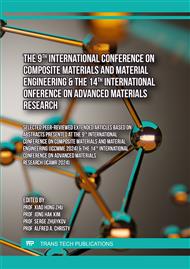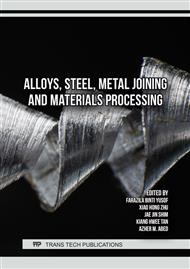p.3
p.9
p.15
p.21
p.27
p.33
p.41
p.51
Effect of Heat Treatment on Mechanical Properties and Corrosion Response of HVOF Sprayed High Entropy Alloy Coatings
Abstract:
Surface and sub-surface related degradation of steels can be minimized using suitable surface coatings. High entropy alloys (HEA) are prominent and emerging materials among many coating materials. The current study investigates the effect of heat treatment of HEA coating on mechanical, metallurgical, and corrosion properties. The HEA coatings on SS304 steel were deposited using a High-Velocity Oxy-Fuel (HVOF) thermal spray process. The developed coatings were furnace heat treated at 700 °C, 900 °C, and 1100 °C, respectively, and their performance was benchmarked with the as-sprayed coatings. The metallurgical, mechanical, and microstructural analyses were performed using X-ray diffraction (XRD), Nanoindentation, Scratch test, and Field Emission Scanning Electron Microscope (FESEM) techniques. The corrosion response of the as sprayed and heat-treated coatings were recorded using a Potentiostat. The results indicated that as-sprayed coatings consisted of a single-phase BCC solid solution; however, the single-phase changed to a dual dual-phase system after heat treatment (BCC+FCC). The 900 °C heat-treated HEA coating exhibited superior mechanical and corrosion properties. But those characteristics started diminishing when the heat treatment temperature exceeded 900 °C. The introduction of the new FCC phase softened the coating, thereby leading to the evolution of microcracks in the coating. These micro-cracks acted as channels for electrolyte diffusion and further corroded the coatings. The current study surmised that HVOF-sprayed HEA coating should not be heat treated at above 900 °C.
Info:
Periodical:
Pages:
3-8
Citation:
Online since:
July 2024
Authors:
Keywords:
Price:
Сopyright:
© 2024 Trans Tech Publications Ltd. All Rights Reserved
Share:
Citation:



